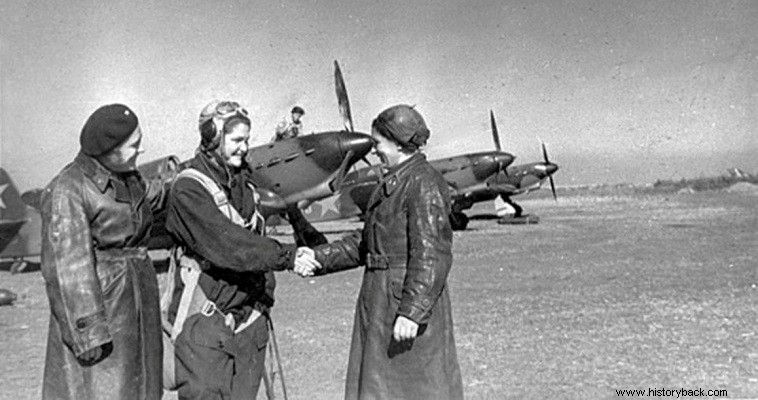
The 586th Fighter Regiment was one of three Soviet aviation units that operated in World War II with female pilots. The regiments in question, among them the famous "Night Witches" regiment, were formed following a proposal by Marina Raskova (first Soviet navigator) to Stalin.
The 586th Fighter Regiment (SM) was formed in December 1941 when the Germans were approaching Moscow. It was joined by 25 female pilots who had just been trained for this purpose in Yak-1 fighters (from 1943 onwards Yak-7 and Yak-9 fighters were available). Its first commander was Yevgenia Prokhorova, but she was killed in March 1942 and was replaced by Tamara Kazarinova, a highly controversial pilot and even more controversial commander who did not fly!
556 BC undertook its first combat mission on 23 February 1942 covering the railway bridge at Saratov from German bombers. However, it took a long time until the second mission was undertaken, mainly due to the death of the commanding officer which had an effect on the unit.
On September 10, 1942, however, eight aircraft of the regiment were deployed in the Stalingrad area participating in the battle. The leader was Raisa Balyaeva, who before being killed succeeded in shooting down three German aircraft. On September 24, two pilots of the unit, Valeria Komiakova and Olga Yamsiskova, were shot down by a German Ju-88 bomber. But Komiakova was also the first loss of the regiment as she was killed on October 6.
On October 22, 586 AD he acquired, due to internal tremors , a male commander, Lt. Col. Alexander Grintenev, while male pilots also joined the regiment, in the absence of women. The regiment then undertook a mission to cover the aircraft production factories in the Voronezh region, shooting down in this phase seven German Ju-88 bombers and three of the excellent German FW-190 fighters.
Four of the German bombers were shot down in an epic dogfight on March 19, 1943 when a total of 42 German bombers appeared to bomb the factories. The Soviet pilots fought heroically, even attempting to ram the enemy aircraft, forcing the rest of the German aircraft to withdraw.
Later in 586 AD it took part in operations at Kursk, but in a defensive role, covering important installations and infrastructure from German bombers. Later the unit was transferred to the Kyiv region. There he succeeded in shooting down six German fighters, while then, covering the area of Zhytomyr, he shot down three more German, bombers this time, aircraft, including a heavy He-177 Greif.
Until February 1945 the unit operated in the Dniester region under the command of the 2nd Ukrainian Front, performing cover and close support missions. He was then transferred to the Hungarian region where he participated in the operations. The regiment was disbanded in November 1945 having flown 2,073 combat missions, having participated in 125 air battles and having to its credit 19 downed.
Two women pilots who became aces also passed from the regiment for a while, the famous Lydia Litvia k, the "white rose of Stalingrad" (depending on the source achieved 5-12 downs) who was killed on August 1, 1943 and Ekaterina Budanova (5 shot down) killed in dogfight with German Me-109s on 19 Jul 1943.
The black points
As mentioned, Major Kazarinova was a strange figure. Although the commander of the 586 was not flying either because of an old injury, or because he had not been trained in the new Yak fighters. It seems that Kazarinova was appointed commander due to her relationship with Lt. Gen. Osipenko without having the proper qualifications. This fact caused friction with the regiment's female pilots, many of whom openly showed their displeasure.
But Kazarinova, with Osipenko's help, kicked most of the reactionary pilots out of the regiment – even the best ones – while assigning others to missions that amounted to a death sentence. Eventually Kazarinova was removed and Lt. Col. Gritenev took over. It is worth noting that the assignment of command to Gritenev was an act against punishment by the higher command because he had refused to sacrifice the pilots of the previous unit he served in by flying in the middle of a sandstorm.
Nevertheless, Gritenev made the 586 AD a unit to be reckoned with, earning the respect of his female pilots with his ethos and skills. But Kazarinova had not forgotten and continued to undermine her former unit by preventing the awarding of the honorary title of "Guard" to the regiment.
